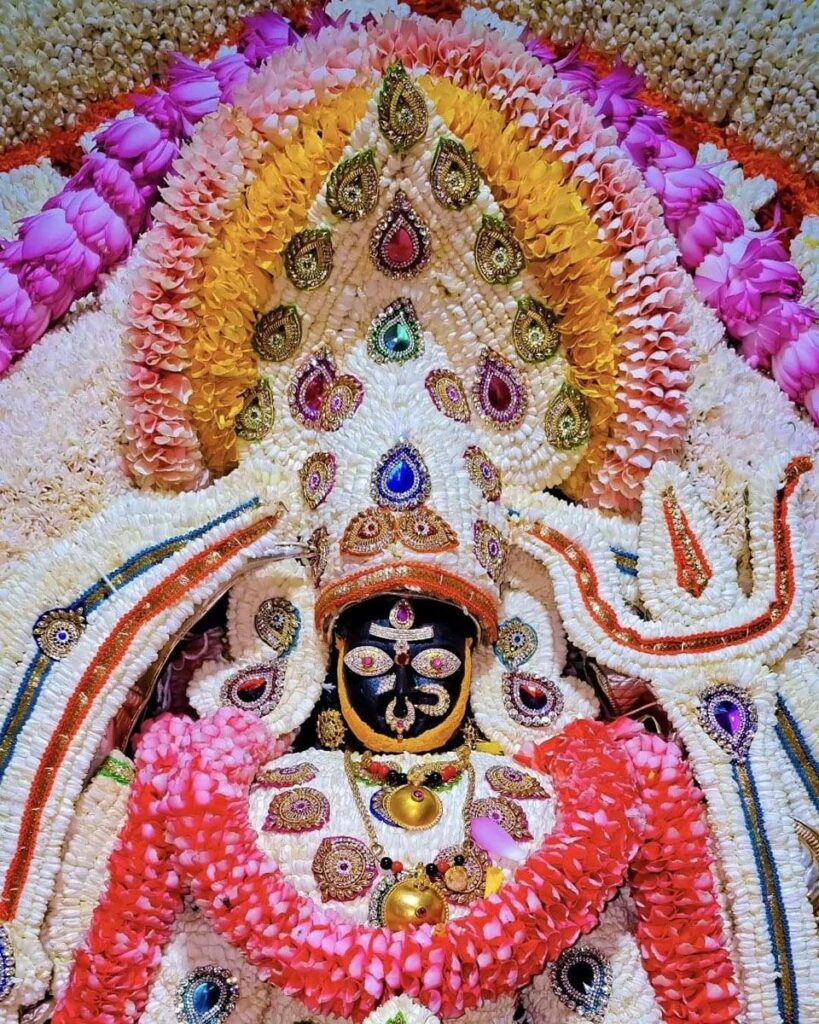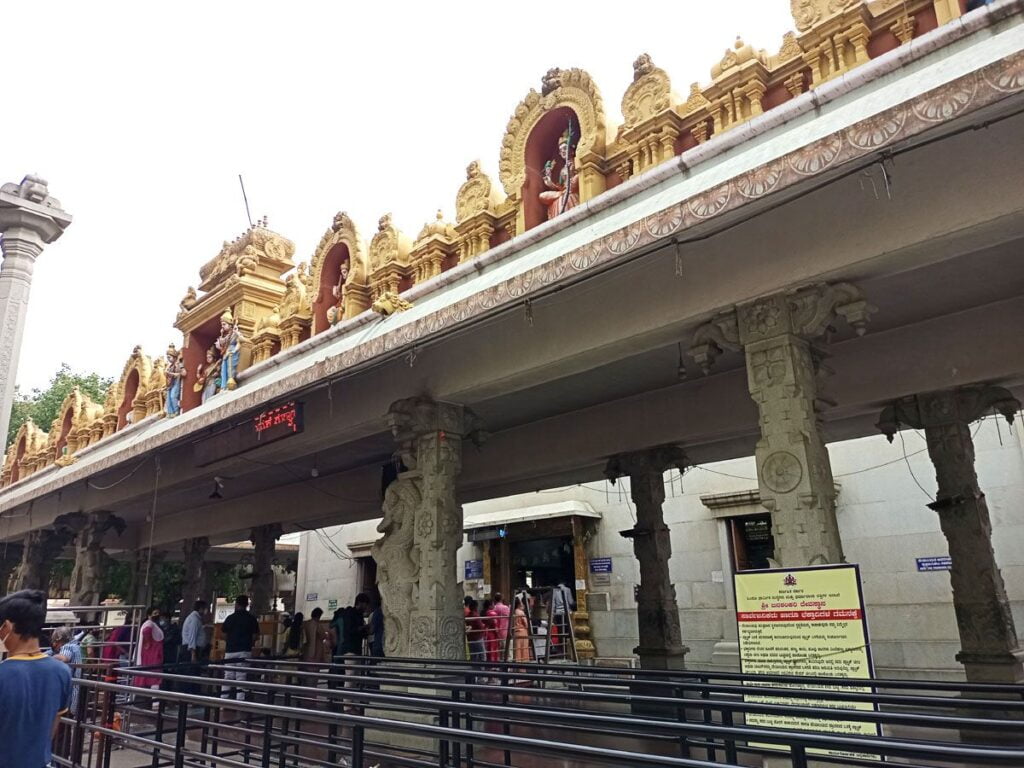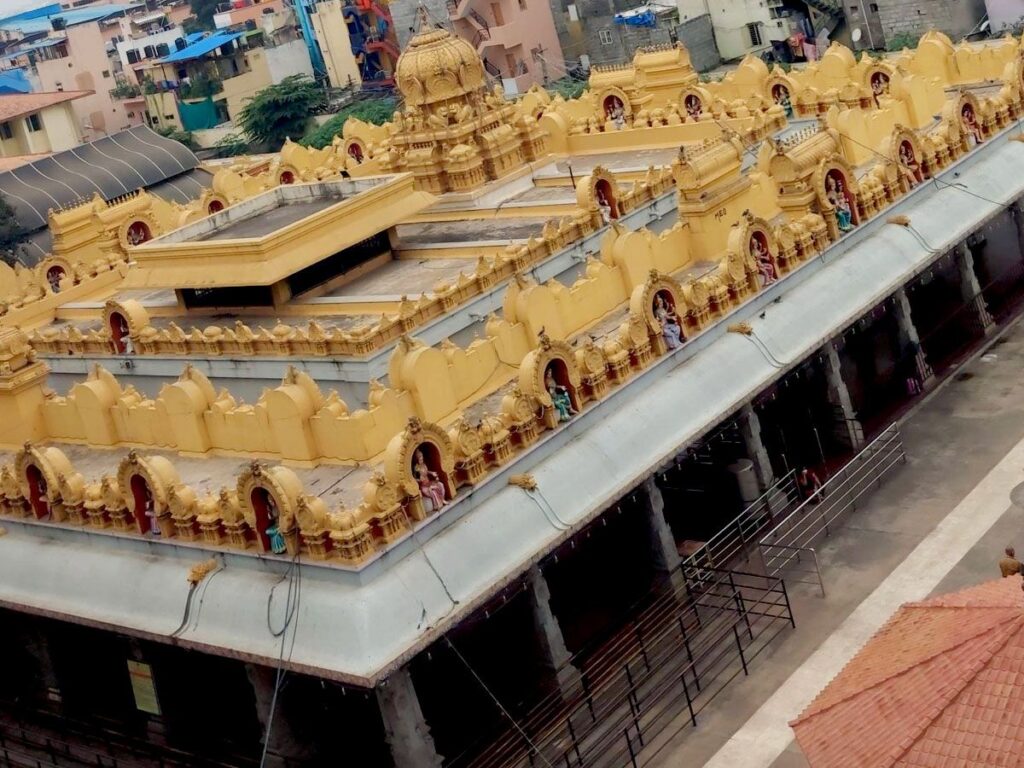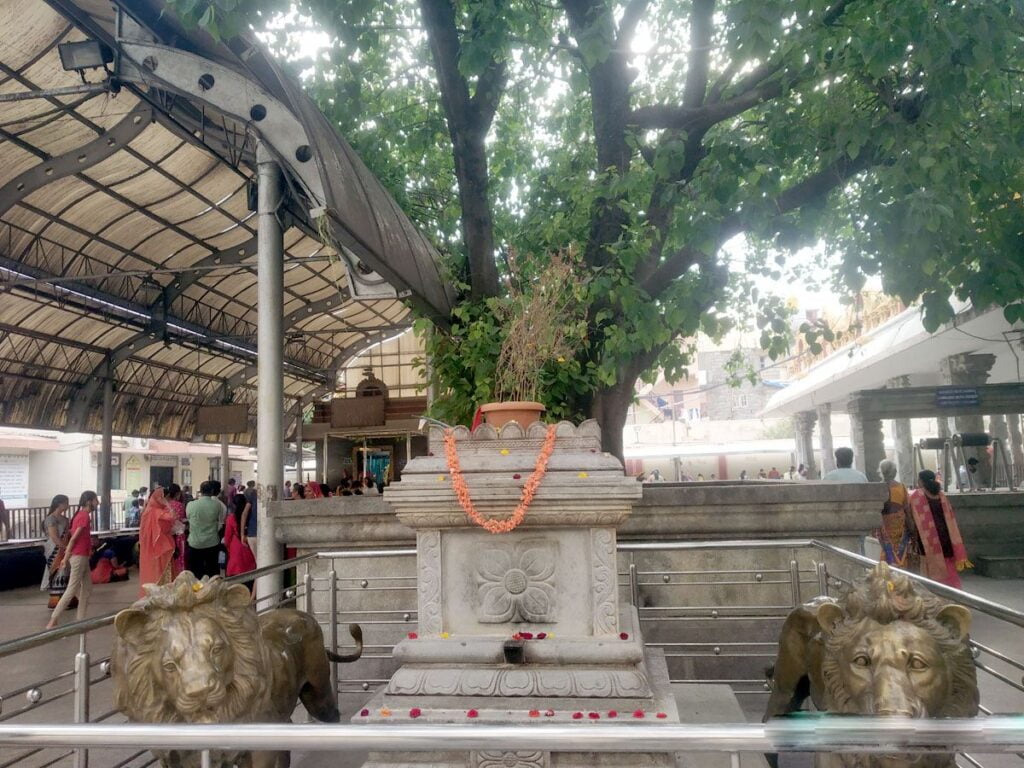Sri Banashankari Temple Bengaluru
Sri Banashankari Temple Bengaluru is a Hindu temple dedicated to the goddess Banashankari, an incarnation of the goddess Parvati. The temple is located in the Banashankari area of Bangalore, Karnataka, India.

Contents
- 1 Sri Banashankari Temple Bengaluru History:
- 2 Legend of Sri Banashankari Temple Bengaluru:
- 3 Significance of Sri Banashankari Temple Bengaluru :
- 4 Myths of Sri Banashankari Temple Bengaluru:
- 5 Sri Banashankari Temple Bengaluru Timing and Rituals:
- 6 Architecture of Sri Banashankari Temple Bengaluru:
- 7 Places to visit near Sri Banashankari Temple Bengaluru:
- 8 FAQ:
- 9 How to reach Sri Banashankari Temple Bengaluru:
- 10 Google Maps:
Sri Banashankari Temple Bengaluru History:
The history of the Sri Banashankari Temple in Bengaluru dates back to the year 1915. It was built by Basappa Shetty, a devotee of Banashankari Amma, who was the family deity of the Chalukya rulers. The temple is located on Kanakapura Road in South Bengaluru and is currently under the administration and management of the Muzrai of the Government of Karnataka.
The original temple in Badami was built by the Chalukyas in the 6th or 7th century AD. It is said that Basappa Shetty was instructed by the goddess in a dream to bring an idol of Banashankari Amma from Badami to Bengaluru. He did so, and the idol was installed in the new temple in 1915.
The temple became popular and the locality derived its name from the goddess, to be known as Banashankari. The temple celebrates its annual festival called Banashankari jatre, in the months of January or February. The festival comprises cultural programmes, boat festival as well as a Rath yatra, when the temple goddess is paraded around the city in a chariot.
Read More>> Gavi Gangadhareswara Temple Karnataka

Legend of Sri Banashankari Temple Bengaluru:
The legend of Sri Banashankari Temple in Bengaluru is a fascinating one. It is said that the temple was built in the 7th century AD by the Chalukya king Pulakeshin II. The king was a great devotee of the goddess Banashankari, and he is said to have built the temple in her honor.
The legend goes that the king was once hunting in the forest when he came across a beautiful woman. The woman was none other than the goddess Banashankari, and she was disguised as a hunter. The king was immediately smitten with the woman, and he asked her to marry him. The woman agreed, but on one condition: that the king would build a temple in her honor.
The king agreed, and he built the temple in the spot where he had met the woman. The temple was a magnificent one, and it was said to be one of the most beautiful temples in the kingdom. The king and the goddess lived happily ever after, and the temple became a popular pilgrimage site for people from all over the kingdom.
The temple has undergone several renovations over the centuries, but it still retains its original beauty. The temple is a popular tourist destination, and it is also a place of worship for many Hindus. The goddess Banashankari is said to be a powerful deity, and she is known for her blessings of fertility, prosperity, and protection.
Here are some of the other legends associated with the Sri Banashankari Temple:
- It is said that the goddess Banashankari once killed a demon named Banasura. The demon was terrorizing the people of the region, and the goddess intervened to save them.
- It is also said that the goddess Banashankari once appeared to a sage named Agastya. The sage was meditating in the forest, and the goddess appeared to him to grant him his wishes.
- The temple is also said to be a place of miracles. Many people have come to the temple to pray for their wishes to be granted, and many have said that their prayers have been answered.
Read More>> 600 yrs Old Ghati Subramanya Temple

Significance of Sri Banashankari Temple Bengaluru :
Religious significance: The temple is dedicated to the goddess Banashankari, who is an incarnation of the goddess Parvati. Parvati is one of the most important goddesses in Hinduism, and she is worshipped by millions of people around the world.
Historical significance: The temple is believed to have been built in the 19th century, making it one of the oldest temples in Bengaluru. The temple has a rich history and is a valuable part of the city’s cultural heritage.
Architectural significance: The temple is a beautiful example of Hindu architecture. The temple complex is large and includes a number of different structures, including the main temple, a smaller shrine to the god Ganesha, and a number of other smaller shrines.
Cultural significance: The temple is a popular destination for both locals and tourists. It is especially crowded on Tuesdays and Fridays, which are considered to be auspicious days for worshipping the goddess Banashankari. The temple is a place where people can come to pray, offer sacrifices, and seek the blessings of the goddess.
Read More>> Shivoham Shiva Temple: 65 Foot Tall Statue of Lord Shiva

Myths of Sri Banashankari Temple Bengaluru:
There are many myths and legends associated with the Sri Banashankari Temple. One of the most popular myths is that the temple was built by a demon named Banasura. Banasura was a powerful demon who had a boon from the god Shiva that he could not be defeated by any man. Banasura became arrogant and began to terrorize the gods and humans.
The gods approached Vishnu for help. Vishnu agreed to help, but he knew that he could not defeat Banasura in a direct battle. So, Vishnu disguised himself as a woman and went to Banasura’s palace. Banasura was attracted to Vishnu’s disguise, and he asked her to marry him. Vishnu agreed, and on the night of their wedding, Vishnu killed Banasura.
After Banasura’s death, Vishnu installed the goddess Banashankari in the temple. The goddess is said to have promised to protect the people of Karnataka from all harm.
Another myth associated with the Sri Banashankari Temple is that the goddess once saved the city of Bengaluru from a plague. In the 18th century, a plague epidemic swept through Bengaluru. Many people died, and the city was in a state of panic.
The people of Bengaluru turned to the goddess Banashankari for help. They prayed to the goddess, and she is said to have appeared to them in a dream. The goddess told the people that she would save them from the plague, but only if they built a temple in her honor.
The people of Bengaluru built the temple, and the plague soon disappeared. The goddess Banashankari is still worshipped in the temple today, and she is considered to be the protector of Bengaluru.
Read More>> Shri Kalabhairaveshwara Temple Bengaluru

Sri Banashankari Temple Bengaluru Timing and Rituals:
The temple is open from 5:30 AM to 1:00 PM and 4:30 PM to 8:00 PM on all days of the week.
Rituals:
- The main puja (worship) at the temple is performed in the morning and evening. Devotees can offer prayers, flowers, and coconuts to the goddess.
- There are also special pujas performed on Tuesdays and Fridays.
- A unique ritual at the temple is offering oil lamps in half-cut lemon peels. This is believed to ward off evil and bring good luck.
- Devotees can also participate in various other rituals, such as abhishekam (sacred bath) and archana (chanting of mantras).
Architecture of Sri Banashankari Temple Bengaluru:
The temple is built in the Dravidian style of architecture, which is characterized by its tall gopuram (tower) and intricate carvings. The temple has a three-tiered gopuram, which is the tallest in Bengaluru. The gopuram is decorated with intricate carvings of gods, goddesses, and mythical creatures. The temple has a large mandapa (hall) in front of the sanctum sanctorum. The mandapa is supported by pillars that are carved with intricate designs. The sanctum sanctorum houses the black stone image of Banashankari. The walls of the sanctum sanctorum are decorated with paintings of gods and goddesses.
Read More>> Kotilingeshwara Temple Karnataka: 108 Ft Massive Lingam in the world
Places to visit near Sri Banashankari Temple Bengaluru:
- Bugle Rock Park: Located nearby, Bugle Rock Park offers a serene environment and a great view of the city. It’s a nice place to relax and enjoy nature.
- Lalbagh Botanical Garden: A famous botanical garden in Bangalore, Lalbagh is a short drive away from Banashankari. It is known for its beautiful gardens, glasshouse, and the Lalbagh Rock.
- Bull Temple (Nandi Temple): This temple is dedicated to the sacred bull Nandi and is one of the oldest temples in Bangalore. It’s situated in Basavanagudi, close to Banashankari.
- Dodda Ganapathi Temple: Another temple in Basavanagudi, it houses a giant monolithic statue of Lord Ganesha. It’s a unique and popular religious site.
- Gavi Gangadhareshwara Temple: This ancient cave temple dedicated to Lord Shiva is known for its unique architecture and the annual phenomenon where sunlight passes through the horns of the Nandi statue to illuminate the Shiva Linga.
- National Gallery of Modern Art (NGMA): If you are interested in art, NGMA in Palace Road is a great place to explore modern and contemporary Indian art.
- Vidhana Soudha: The state legislature building of Karnataka is an architectural marvel. While you may not be able to enter without official business, the building is impressive to view from the outside.
- ISKCON Temple Bangalore: The International Society for Krishna Consciousness (ISKCON) Temple is a magnificent temple dedicated to Lord Krishna. It’s a peaceful place with beautiful architecture and a cultural complex.
- Bangalore Fort: Explore the remains of the Bangalore Fort, which has historical significance and is a reminder of the city’s past.
- Gandhi Bazaar: If you enjoy shopping, Gandhi Bazaar is a bustling market where you can buy traditional silk sarees, spices, and other local products.
FAQ:
- What is the history of Sri Banashankari Temple?
- Provide a brief overview of the temple’s origins and historical significance.
- Where is the temple located?
- Include the address and any landmark or directional information to help visitors find the temple easily.
- What are the temple’s opening hours?
- Specify the regular operating hours and any variations during special events or festivals.
- Are there any entry fees?
- Mention if there is a fee for entry or any specific charges for special events or rituals.
- What are the main festivals celebrated at Sri Banashankari Temple?
- Highlight the major festivals and events celebrated at the temple, providing details on their significance and schedule.
- Can visitors participate in rituals or pujas?
- Provide information on whether visitors can actively participate in temple rituals and pujas, and if so, any guidelines to follow.
- Is photography allowed inside the temple?
- Specify the temple’s policy regarding photography or videography within the premises.
- Are there any dress code requirements for visitors?
- Inform visitors about any specific dress code they should adhere to while visiting the temple.
- Is there parking available at the temple?
- Provide details on parking facilities, including any charges and guidelines.
- Are there nearby accommodations for visitors?
- Mention any hotels, guesthouses, or lodging options available in the vicinity of the temple.
- Is the temple accessible for differently-abled individuals?
- Specify whether the temple has facilities for differently-abled individuals, such as ramps or elevators.
- Are there any restrictions or guidelines for visitors?
- Inform visitors about any specific rules or guidelines they should be aware of while inside the temple premises.
How to reach Sri Banashankari Temple Bengaluru:
By Public Transportation:
- Bus:
- Bengaluru has an extensive bus network. You can check the nearest bus stop to your location and find a bus that goes towards Banashankari.
- You can use online platforms or mobile apps to check the bus routes and timings.
- Metro:
- If you are closer to the metro station, you can use the Namma Metro. The nearest metro station is the Banashankari Metro Station.
- From the metro station, you can take a taxi, auto-rickshaw, or walk to reach the temple.
By Auto-rickshaw or Taxi:
- Auto-rickshaw:
- Auto-rickshaws are commonly available in Bengaluru. You can hire one and provide the temple’s name as your destination.
- Ensure the driver uses the meter or agree on a fare before starting the journey.
- Taxi:
- Taxis, including app-based services, are also available. You can use a taxi app or hire a local taxi to reach the temple.
By Car:
- Own Vehicle:
- If you’re driving, you can use navigation apps like Google Maps or Waze to get directions to Sri Banashankari Temple.
- The temple is located in the Banashankari area, so you can set it as your destination on the navigation app.
- Rental Car:
- If you don’t own a vehicle, you can rent a car from various car rental services available in Bengaluru and use navigation to reach the temple.

One Comment